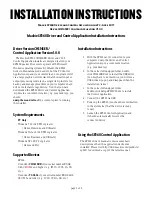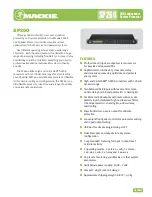
A p p l i c a t i o n N o t e s
C-9
proto
allows a specific protocol to be matched against. Protocol names
may be used. However, the protocol may also be given as a DECI-
MAL number, allowing for rules to match your own protocols, or
new ones which would out-date any attempted listing.
The special protocol keyword
tcp/udp
may be used to match either a TCP or
a UDP packet, and has been added as a convenience to save duplication of
otherwise-identical rules.
The
from
and
to
keywords are used to match against IP addresses (and
optionally port numbers). Rules must specify BOTH source and destination
parameters.
IP addresses may be specified in one of two ways: as a numerical address
/
mask, or as a hostname
mask
netmask. The hostname is of the dotted numeric
form.
There is a special case for the hostname
any
which is taken to be 0.0.0.0/0
(see below for mask syntax) and matches all IP addresses. Only the presence
of "any" has an implied mask, in all other situations, a hostname MUST be
accompanied by a mask. It is possible to give "any" a hostmask, but in the
context of this language, it is nonsensical.
The numerical format "x
/
y" indicates that a mask of y consecutive 1 bits set is
generated, starting with the MSB, or a hexadecimal number of the form
0x12345678. Note that all the bits of the IP address indicated by the bitmask
must match the address on the packet exactly; there isn't currently a way to
invert the sense of the match, or to match ranges of IP addresses which do not
express themselves easily as bitmasks.
If a
port
match is included, for either or both of source and destination, then
it is only applied to TCP and UDP packets. If there is no
proto
match
parameter, packets from both protocols are compared. This is equivalent to
"proto tcp/udp". When composing
port
comparisons, either the service name
or an integer port number may be used. Port comparisons may be done in a
number of forms, with a number of comparison operators, or port ranges may
be specified. See the examples for more information.
The
all
keyword is essentially a synonym for "from any to any" with no other
match parameters.
Following the source and destination matching parameters, the following
additional parameters may be used:
The
with
keyword is used to match irregular attributes that some packets may
have associated with them. To match the presence of IP options in general,
use
with
ipopts
. To match packets that are too short to contain a complete
header, use
with
short
. To match fragmented packets, use
with
frag
. For
more specific filtering on IP options, individual options can be listed.
Before any parameter used after the
with
keyword, the word
not
or
no
may
be inserted to cause the filter rule to only match if the option(s) is not present.
Summary of Contents for JetFusion 2008
Page 12: ...viii 2 0 0 0 A 2 G B 2 2 0 0...
Page 20: ...1 6 2 0 0 0 A 2 G B 2 2 0 0...
Page 174: ...6 12 2 0 0 0 A 2 G B 2 2 0 0...
Page 184: ...8 4 2 0 0 0 A 2 G B 2 2 0 0...
Page 186: ...A 2 2 0 0 0 A 2 G B 2 2 0 0...
Page 187: ...M e n u M a p A 3...
Page 188: ...A 4 2 0 0 0 A 2 G B 2 2 0 0...










































